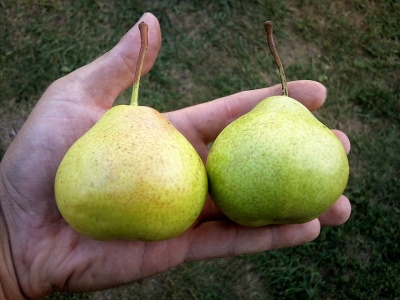
- Authors: folk selection
- Name synonyms: Bessemaynka, Sugar Pear
- Fruit weight, g: 70-80
- Ripening terms: summer
- Fruit picking time: In the end of August
- Appointment: universal
- Growth type: medium vigor or vigorous
- Yield: high
- Transportability: high
- Height, m: 6
Among the abundance of pear varieties, there are not only those developed by professional developers. The results of folk selection are also quite widespread and can prove themselves no worse than the recognized branded varieties. A vivid confirmation of this is the Bessemyanka pear, which should be studied very carefully.
Description of the variety
This tree is considered a versatile option. It has official synonyms - Sugar Pear and Bessemaynka. There are both medium-sized and large specimens. The highest probable height is 6 m. The edges of the long branches are oriented upward. Other nuances:
- suitability for the northwest, the center of the European part of Russia, the Volga region and the Volga-Vyatka region;
- moderately dense crown in the format of a wide pyramid;
- thin long shoots;
- green foliage of medium size, having an ovoid or oval-ovoid configuration;
- 5, 6 or 7 flowers in each inflorescence;
- the flowers themselves are white, not too large in size, have very long pedicels and rounded petals.
Fruit characteristics
The usual weight of pears is 0.07-0.08 kg. They are characterized by a shortened shape and a bumpy surface. Overall length is below average. The cover color is usually absent, sometimes a slight "tan" is found on the side facing the sun. The peel is slightly rough and dense, the moderately long peduncle is thin and curved in the shape of an arc.
Taste qualities
Bessemyanka's pulp is tender and juicy. This yellow-white mass is often granular. In general, a pleasant sweetness and a strong aroma are noted. The share of sugars reaches 9.1%. The pectin content is 6.6%. The concentration of titratable acids is 0.12%.
Ripening and fruiting
The Bessemyanka variety is one of the summer pears. Harvesting usually takes place at the end of August. The consumer period lasts from 7 to 10 days. You can remove the fruits for 8-9 years after planting. From that moment on, the harvest will be formed annually.

Yield
The productivity level is high. The declared ability to produce 260-270 kg of fruit per 1 tree. At the same time, it is very important to take care of the plant and keep it in good shape. Important: when the pears are ripe, they will crumble. The winter hardiness of the variety is beyond doubt.
Disease and pest resistance
Resistance to most pathologies is relatively high. But the danger of being hit by a scab is significant. During periods of massive outbreaks of infection, fruits and foliage can be severely affected. Protection measures are the same as for other plants.
Landing
Bessemyanka should be planted at the very beginning of spring. At the same time, they anticipate the moment when the kidneys begin to form. But you can get to work in the fall - from the beginning of October until the onset of the early cold weather.Meter depth pits are prepared in advance. The disembarkation procedure itself is nothing special.


Growing and care
It is necessary to irrigate the soil often enough, but in limited quantities. Chip mulch is highly recommended. Fertilizers should be applied and the crown should be carefully formed. Also in gardening descriptions it is advised to cut off all dry branches. The young roots of Bessemyanka do not tolerate the cold very well, and therefore it is recommended to cover them with a large amount of snow in winter.
We must remember that we need protection as well. They are weeded quite regularly. You can plant lupine, which provides the enrichment of the earth with useful substances.
Mandatory watering is carried out in the last third of spring and in the middle of summer. Also, it must be resorted to if a severe drought occurs. Usually they use 5-7 liters of water per 1 adult pear.
After each watering, the soil needs to be loosened. Fertilizers begin to be laid in the season following the formation of the first fruits. Most often, top dressing is used in spring and autumn. Fertilization in summer is not advisable. Mineral compositions are laid annually, and organic matter is used once every 3 years.
For fertilizing Bessemyanka, the use of peat or humus is recommended. Mulching will also help to achieve this goal. Sawdust and dry grass are considered good mulch. You can also use straw and paper. Dry leaves can also be added to the soil, but only after preliminary composting.




Like any other fruit trees, the pear needs protection from various diseases and pests. When planting a pear on your site, you need to know in advance what diseases you should beware of. To successfully carry out the struggle, it is necessary first to correctly identify the cause of the problem. It is important to distinguish signs of disease from manifestations of the presence of insects, mites, caterpillars and other types of pests.





































































